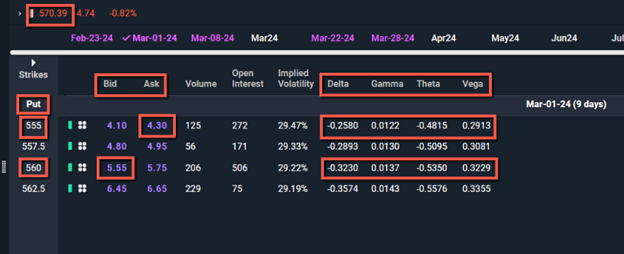Delta Is Lead Dog for Vertical Credits
I model out several vertical credit spreads every day in MTM’s Group Coaching class. And every day I talk about delta being the most important greek, in my opinion, for vertical credits. Most option traders associate credit spreads as mostly a positive theta trade. I am going to show you why I believe delta is usually the bigger factor.
When you consider selling a vertical credit spread as an option trader, probably the first thing you think of is time decay. Of course, positive theta is a very important aspect and is always helping you unless the position moved through breakeven. But if there are more than a couple of days to go to expiration, there is another option greek that can get you to your profit destination quicker than positive theta and that is delta.
Two Types of Vertical Credit Spreads
There are two types of vertical credit spreads: the bull put and the bear call. If selling a call credit spread (bear call), an option trader believes the stock will stay below a certain area like resistance for maximum profit. Trade is initiated by selling a call and buying a higher strike call with the same expiration. A put credit spread (bull put) is created by selling a put and buying a lower strike put with the same expiration. The option trader believes the stock will stay above a certain level like support for maximum profit. Let’s look at an example.
Bull Put Example in NFLX
Let’s say an option trader expects Netflix Inc. (NFLX) to stay above $560 by expiration in 9 days. He or she sells the 560 put and buys the 555 put, as seen below.

The maximum profit on the trade is the credit received, which in this case is $1.25 (5.55 – 4.30) or $125 in real terms if the stock closes at or above $560 at expiration. The positive theta on the trade is just over 0.05 (0.5350 – 0.4815) a day. That means for every day that passes, the spread’s premium will decline by the theta amount. Not bad, right? But look at the positive delta on the trade. It is just over 0.06 (0.3230 – 0.2580). That means if the stock does move $1 higher and further away from the 560 short put strike, the spread’s premium will decrease by that amount.
Think of it this way: If the stock rose $3 over 2 days, the premium would decline $0.18 (0.06 X 3) from theta and 0.10 (0.05 X 2) from theta. Starting with a credit of $1.25 and keeping all other variables constant, the new premium would be $0.97 (1.25 – 0.18 – 0.10). A profit could be made of 0.28 or $28 in real money. The positive delta of the position contributed more to the profit than the positive theta in this case, and truth be told that should happen more times than not. Now don’t get me wrong, if the stock headed lower, positive delta would be working against the position and positive theta for the position up to its breakeven point.
Positive Theta IS Important
Positive theta is very important when it comes to potential profit when trading vertical credit spreads. It will always be on your side provided the position stays above breakeven. That said, an expected move away from the short option as forecast can make the vertical spread position a whole lot more profitable much sooner than with positive theta alone.
John Kmiecik, Market Taker Mentoring
